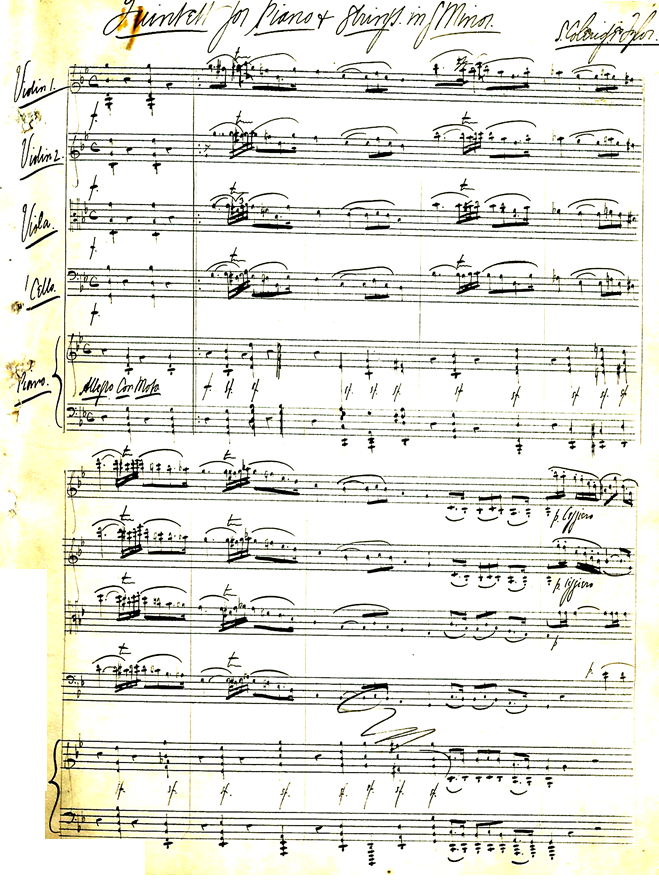Presents
Samuel Coleridge-Taylor
Piano Quintet in g minor, Op.1-World Premiere Edition
 Samuel
Coleridge-Taylor was 18 years old and a student at the Royal College of Music in
London when he composed his Piano Quintet in g minor. In four movements, the
opening Allegro con moto begins in an almost orchestral fashion as the strings
bring forth the main theme together played in octaves. A certain heaviness and
density of the writing recalls Brahms' technique. And here and there one hears
touches of Dvorak, his favorite composer. The lanquid second
movement, Larghetto, opens with a very romantic cello solo. The middle section
interrupts the peaceful mood with a passionate interlude. Next comes a restless
and rather dramatic Scherzo full of energy and very rhythmic. The trio section
provides a strong contrast by virtual of its singing and more lyrical quality.
The finale, Allegro molto, bursts forth out of the gate full of forward motion.
The pace and excitement are kept up throughout.
Samuel
Coleridge-Taylor was 18 years old and a student at the Royal College of Music in
London when he composed his Piano Quintet in g minor. In four movements, the
opening Allegro con moto begins in an almost orchestral fashion as the strings
bring forth the main theme together played in octaves. A certain heaviness and
density of the writing recalls Brahms' technique. And here and there one hears
touches of Dvorak, his favorite composer. The lanquid second
movement, Larghetto, opens with a very romantic cello solo. The middle section
interrupts the peaceful mood with a passionate interlude. Next comes a restless
and rather dramatic Scherzo full of energy and very rhythmic. The trio section
provides a strong contrast by virtual of its singing and more lyrical quality.
The finale, Allegro molto, bursts forth out of the gate full of forward motion.
The pace and excitement are kept up throughout.
Samuel Coleridge-Taylor (1875-1912) was born in London, the product of a mixed race marriage, his father, a doctor, being an African from Sierra Leone and his mother a white Englishwoman. His father returned to Africa when he was a small boy and he was brought up by his mother in Croydon. His musical talent showed itself early and he was admitted to study the violin at the Royal College of Music where he eventually concentrated on composition when his gifts were ascertained. His teacher was the renowned composer, Sir Charles Villiers Stanford. Stanford immediately recognized his young student's immense talent, later calling him the most gifted of all of the many students he taught that subsequently became famous composers. Not surprisingly, the music shows the influence of the idols of Standford's own teachers--Carl Reinecke and Friedrich Kiel as well as his idol Brahms. Coleridge-Taylor and his compositions gained considerable fame during his lifetime. His oratorio Hiawatha's Wedding Feast for a time became as popular as Handel's Messiah and Mendelssohn's Elijah. He made several visits to the United States because of his interest in American Negro cultural life. His fame was such that he made three visits the United States. On one visit, he was invited to the White House by Theodore Roosevelt. On another, he was asked to conduct the New York Philharmonic. At the time, Mahler was its music director. Coleridge-Taylor's success was such that they nicknamed him the "African Mahler."
The parts to his Piano Quintet have never been commercially printed. Recordings used handwritten parts made by copyists from the manuscript score which resides at the Royal College of Music in London. Our edition, edited by senior editors Garik Hayrapetyan and Santo Neuenwelt, is based on the above-mentioned manuscript, pictured on the left. Although an early work, it is not a student work but of professional quality and certainly strong enough to be heard in concert and can be warmly recommended to experienced amateur ensembles.
Parts: $44.95